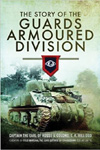|
THE STORY OF THE GUARDS ARMOURED DIVISION
by Captain the Earl of Rosse
and Colonel E R Hill DSO
|
 As its title suggests, this 2017 re-release of an edition first published in 1956 narrates the activities of the Guards Armoured Division from its formation on 17th June 1941 to its ‘Farewell to Armour’ parade on 9th June 1945. It briefly covers its creation and years of training in England and then takes us, at pace but in detail, through the initial hard fights in Normandy, the rush of the ‘great swan’ to Brussels, holding against the Ardennes counter-offensive, and then the blow-by-blow grind into and then up through Germany. As its title suggests, this 2017 re-release of an edition first published in 1956 narrates the activities of the Guards Armoured Division from its formation on 17th June 1941 to its ‘Farewell to Armour’ parade on 9th June 1945. It briefly covers its creation and years of training in England and then takes us, at pace but in detail, through the initial hard fights in Normandy, the rush of the ‘great swan’ to Brussels, holding against the Ardennes counter-offensive, and then the blow-by-blow grind into and then up through Germany.
~
The authors explain the challenge of writing an account focusing at the divisional level: too senior for the intimacy of a regimental or battalion account, too junior to be concerned with politics or strategy, and their fear that a ‘catalogue of pure military events’ will be tedious, although the Guards Armoured Division met each challenge head-on and slayed the fear.
The description is chronological and organised and achieves a fine balance describing the Division’s place in the order of things and the activities of the individual battle groups and battalions. There is plenty of context to explain why each manoeuvre was planned and how the Division and its units integrated with their neighbours, but still plenty of detail describing the actions of troops, platoons and individuals. Unlike modern accounts which pick several individuals to highlight and to carry the story, this account relies on the sequence of events but still peppers the text with descriptions of the surroundings that the soldiers found themselves in, and accounts of notable individual activities.
My first overall impression is of the Division as an immensely complicated fighting machine with many integrated moving parts but still only a relatively small player in a huge military machine fighting at a scale that the modern soldier must work hard to comprehend. This book does not dwell on the wider politics or strategies but includes enough for us to understand just how vast the overall endeavour was.
My second is that, however large the scale, it is the contribution of individuals and their dedication to the common aim that matters most. This narrative never gets lost in the weeds but still contains enough detail on the individuals to convey the value of their activities and sacrifice.
My third is that this book does not shy away from the cost. It describes the many great achievements of the Division in its eleven months of hard fighting, but the reader cannot escape from the losses, the attrition, as it ground its way up through France, Belgium and Germany. Terribly sobering.
Finally, I note that the Earl of Rosse captures throughout his account ‘the value of regimental loyalty, comradeship, discipline and mutual trust between all ranks’ that, as Field Marshal the Lord Guthrie writes in his foreword, are as ‘fundamental today as they were when the Guards Armoured Division was in action’. These shine out of the narrative, reminding us why the Guards Armoured Division and its activities remain a highlight in the history of the Guards.
A great read with the perfect balance of information, context and character. Septem Juncta in Uno
Simon Soskin
Pen & Sword (2017)
|
|